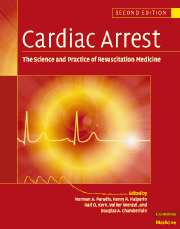Book contents
- Frontmatter
- Contents
- List of contributors
- Foreword
- Preface
- Part I Introduction
- Part II Basic science
- Part III The pathophysiology of global ischemia and reperfusion
- Part IV Therapy of sudden death
- 23 Prevention of sudden cardiac death
- 24 Sequence of therapies during resuscitation: application of CPR
- 25 Transthoracic defibrillation
- 26 Automated external defibrillators
- 27 Public access defibrillation
- 28 The physiology of ventilation during cardiac arrest and other low blood flow states
- 29 Airway techniques and airway devices
- 30 Manual cardiopulmonary resuscitation techniques
- 31 Mechanical devices for cardiopulmonary resuscitation
- 32 Invasive reperfusion techniques
- 33 Routes of drug administration
- 34 Adrenergic agonists
- 35 Vasopressin and other non-adrenergic vasopressors
- 36 Antiarrhythmic therapy during cardiac arrest and resuscitation
- 37 Acid–base considerations and buffer therapy
- 38 Cardiac arrest resuscitation monitoring
- 39 Special considerations in the therapy of non-fibrillatory cardiac arrest
- 40 Cardiocerebral resuscitation: a new approach to out-of-hospital cardiac arrest
- 41 Thrombolysis during resuscitation from cardiac arrest
- 42 Percutaneous coronary intervention (PCI) after successful reestablishment of spontaneous circulation and during cardiopulmonary resuscitation
- 43 Emergency medical services systems and out-of-hospital cardiac arrest
- 44 In-hospital resuscitation
- 45 Complications of CPR
- 46 Bringing it all together: state-of-the-art therapy for cardiac arrest
- Part V Postresuscitation disease and its care
- Part VI Special resuscitation circumstances
- Part VII Special issues in resuscitation
- Index
33 - Routes of drug administration
from Part IV - Therapy of sudden death
Published online by Cambridge University Press: 06 January 2010
- Frontmatter
- Contents
- List of contributors
- Foreword
- Preface
- Part I Introduction
- Part II Basic science
- Part III The pathophysiology of global ischemia and reperfusion
- Part IV Therapy of sudden death
- 23 Prevention of sudden cardiac death
- 24 Sequence of therapies during resuscitation: application of CPR
- 25 Transthoracic defibrillation
- 26 Automated external defibrillators
- 27 Public access defibrillation
- 28 The physiology of ventilation during cardiac arrest and other low blood flow states
- 29 Airway techniques and airway devices
- 30 Manual cardiopulmonary resuscitation techniques
- 31 Mechanical devices for cardiopulmonary resuscitation
- 32 Invasive reperfusion techniques
- 33 Routes of drug administration
- 34 Adrenergic agonists
- 35 Vasopressin and other non-adrenergic vasopressors
- 36 Antiarrhythmic therapy during cardiac arrest and resuscitation
- 37 Acid–base considerations and buffer therapy
- 38 Cardiac arrest resuscitation monitoring
- 39 Special considerations in the therapy of non-fibrillatory cardiac arrest
- 40 Cardiocerebral resuscitation: a new approach to out-of-hospital cardiac arrest
- 41 Thrombolysis during resuscitation from cardiac arrest
- 42 Percutaneous coronary intervention (PCI) after successful reestablishment of spontaneous circulation and during cardiopulmonary resuscitation
- 43 Emergency medical services systems and out-of-hospital cardiac arrest
- 44 In-hospital resuscitation
- 45 Complications of CPR
- 46 Bringing it all together: state-of-the-art therapy for cardiac arrest
- Part V Postresuscitation disease and its care
- Part VI Special resuscitation circumstances
- Part VII Special issues in resuscitation
- Index
Summary
Historical review of routes of drug administration
Baggellardus, a contemporary of Columbus, observed Indians applying fumigation to the mouth or anus of apparently dead persons and brought the technique to Europe. In the aftermath, during the seventeenth and eighteenth century, scientific societies all over Europe recommended warmth, artificial respiration, rectal fumigation with tobacco smoke, friction, and bleeding for resuscitation purposes. Insufflation of air, tobacco smoke, or vaporized aromatic plants either by mouth, the nostrils, or the rectum was common, stimulants were administered by nasogastric or rectal tubes, and topical application with “spirits of wine, hartshorn, or, which is perhaps the most powerful, the spirits of sal ammoniac” were used. Eventually, tobacco insufflation was abandoned when Brodie in 1811 published his observations that even a dog was easily killed by injection of smoke into the rectum.
History of intravenous techniques
Bronze syringes had been known since antiquity, when Heron of Alexandria had recommended his pus extractor for injection of fluids. Blood circulation was discovered in 1616 by William Harvey, and in 1656 the British astronomer Sir Percival Christopher Wren (1632 to 1723) first demonstrated intravenous therapy by injecting wine and beer into a dog. He noted that “the opium…did within a short time stupefy, though not kill the dog.” Three other physicians, acting independently of Wren, described intravenous (iv) therapy: Johann Sigismund Elsholtz (1623 to 1688), who infused water into the brachial artery of a drowned woman in 1661, the surgeon Carlo Fracassati (ar. 1630 to 1672), and lastly Johann David Major (1634 to 1693), a medical doctor.
- Type
- Chapter
- Information
- Cardiac ArrestThe Science and Practice of Resuscitation Medicine, pp. 614 - 638Publisher: Cambridge University PressPrint publication year: 2007
- 3
- Cited by



